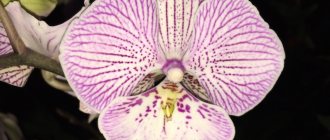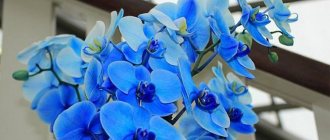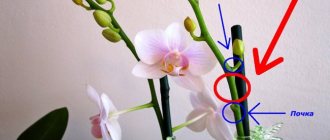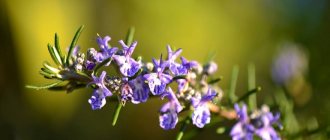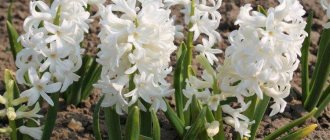This magnificent phalaenopsis hybrid will delight you with its extreme durability and magnificent aroma. The leaves should not be more than slightly warmed by the sun. Full light in winter. Ideal for a windowsill.
Liodoro orchid is an ornamental plant of the phalaenopsis family. This is one of the most beautiful representatives of its genus, which, with good care, will delight you with exotic flowers and a dizzying aroma for several months in a row.
Anyone who has fallen in love with the charm of this delicate tropical beauty and would like to have it in their home should choose an orchid such as 'Liodoro'. Orchids prefer a bright, but not sunny place; east or west windows are ideal. A sufficient amount of water is of great importance. Water once a week or treat the plants by immersing them in room-warm, lime-free water and mist the orchid regularly. In winter, watering is reduced. During the growing season from May to October, the "Liodoro" orchid likes to give a sip of orchid fertilizer twice a week. After flowering, each peduncle is pinched off above the eye, from which new peduncles appear.
History of origin
In the natural environment of our planet, there are several thousand orchids with beautiful flowers and aroma. But there is no limit to perfection, and people select new and new varieties of this flower that enchants at first sight. Orchid Liodoro or Sweet Memories, as the name translates, is one of these. This hybrid variety appeared relatively recently - in 1982 in the USA. A complete description of the Liodora orchid was given by Rex Sith, the creator of this variety by crossing two other popular species - Phalaenopsis Deventeriana and Phalaenopsis violacea. The goal was to obtain a beautiful ornamental plant with flowers of various colors and a pleasant aroma. And it succeeded: in the first years of its existence alone, Liodoro received more than 30 awards at various international competitions and exhibitions.
Phalaenopsis violacea
Distinctive feature
Phalaenopsis Liodoro has several distinctive features:
- Long flowering . With good care and compliance with all its subtleties, it can bloom for up to 2 years.
- The variety is revolving . This means that as soon as one flower stalk fades, it is replaced by another. There is no rest period.
- Pleasant aroma . Liodoro is distinguished from other species by the smell of lily of the valley with notes of lime.
Attention! This type of orchid is a high-maintenance plant. Only after receiving proper care will it grow well and delight you with flowering.
Description of the flower
"Liodoro" is a special type of orchid because, unlike its sisters, its flowers smell strongly of fresh fruit. It is difficult to accurately determine the aroma, so it is better to see for yourself the pleasant smell of beautiful flowers.
The plant can reach a height of 70 cm, has dense dark green peduncles and wide, slightly wavy leaves of a bright green color. The leaves are large, fleshy, glossy, and can grow up to 25 cm.
A fully opened flower reaches 7 cm in diameter; there can be from 5 to 7 of them on a branch. The calyx looks like a star with five oval petals in two colors - the main one and specks on it. Towards the center of the flower, the specks become thicker and darker. Shades range from soft pink to deep lilac and purple. With proper care, the orchid produces a lot of flowers on different branches; flowering lasts up to two years.
The aroma of blooming liodora is subtle, reminiscent of lilies of the valley with refreshing notes of lime.
The photo shows the Liodoro orchid in all its glory. Agree, it looks very attractive, life-affirming, gentle and bright at the same time. Such decoration will make any home fresher and brighter.
To ensure that the sweet memory orchid (one of the varieties of Liodoro) does not actually become just a sweet memory, it is important to provide it with optimal conditions and proper care - this is not difficult.
Flowering period
With proper care, Liodoro can bloom all year round. The plant must reach the age of one and a half years, after which it will flower for more than two years.
If out of several flower stalks only one blooms, then this is a signal that the flower lacks minerals. And the complete absence of blooming flowers indicates problems with lighting, temperature changes or rearranging the pot.
At the end of flowering, you should not cut off the flower stalks, because they continue to develop from above. Remove it when it is completely dry.
Where does it grow in nature?
This is a hybrid species obtained through artificial crossing, so it cannot be found in the wild. But you can use a flower for an unusual, stylish and very attractive design of a veranda, terrace, balcony or winter garden (greenhouse). But the “parents” of this charming hybrid can be found on the rocky slopes and palm trees of Malaysia. The photo shows Phalaenopsis Liodoro in landscape design.
Home care
Caring for Liodoro at home is quite simple - like all vines, this hybrid is unpretentious in conditions, the main thing for longevity and lush flowering is to avoid excessive moisture in low light. It is very flowery and robust, as the plants bloom for several months even with minimal care.
Choosing a location and lighting
This hybrid needs a lot of light - up to 13 hours a day. In this case, the light should be direct, not diffused. In the summer season, you should not place the plant pot in direct sunlight. And in the winter season, it is important to extend daylight hours with the help of a special light lamp.
Temperature
For a plant to bloom, two temperature conditions are important:
- Not lower than 22-24 degrees Celsius;
- Mandatory fluctuations between night and day temperatures of 5 degrees.
If there is no temperature difference, the orchid may not bloom.
Humidity and watering
In summer, allow the plant to dry out, then water thoroughly. Water more carefully in winter. Use only water at room temperature. Drought is contraindicated for Liodoro, but it should not be overly moistened either. The optimal method of watering: immerse a container with holes for a quarter of an hour in a container with filtered water, possibly with fertilizing. This time is enough for the roots to absorb as much moisture as they need. After this, you need to let the excess water drain for a couple of minutes and return the pot to its usual place in the pot. There is no need to spray the entire plant. If dust appears on the leaves, wipe them with a damp cloth.
Important! The water for watering the orchid should not be cold; it is better to heat it to 25-30 degrees. Watering should be done in the morning.
Transfer
For replanting, it is safer to use a ready-made substrate from a flower shop. If it is possible to collect high-quality ingredients, the substrate can be prepared from equal amounts of river sand, peat, sphagnum, perlite and coniferous tree bark.
The plant is replanted as needed, but not more than once every two years. When replanting, you need to remove all damaged roots, sprinkle the cut areas with cinnamon powder or crushed charcoal. You can immediately give fertilizing - magnesium, phosphorus and potassium. Fertilizing is repeated every 2 weeks until flowering begins.
Selection of pot
Liodoro can grow in a ceramic pot, but since the orchid's roots love light, it is better to keep it in a transparent plastic container. Various options for pots can be viewed here.
Possible difficulties during cultivation
When growing Liodoro orchid at home, some difficulties may arise:
- Drying roots - you need to be more careful about watering the flower;
- Closed pot, dark windowsill - lack of light for the roots;
- Water getting into flower rosettes, excessive moisture of leaves and roots;
- Abuse of fertilizing - professionals recommend diluting the finished product two to three times so as not to burn the sensitive roots of the plant;
- Errors in transplantation.
Useful video
Watch a video about this variety:
Find out interesting things about other groups and varieties of phalaenopsis: Big Lip, Golden, Wild Cat, Stone Rose, Kimono, Cleopatra, Legato, Manhattan, Mix, Mini, Multiflora, Narbonne, Parrot, Ravello, Sogo, Surf Song, Frontera, Charmer, Chengdu , Schiller
Patience and love, conscientious implementation of care recommendations, knowledge of the characteristics of these magnificent plants - and your orchid will feel great indoors.
The most popular varieties of Phalaenopsis Liodoro
Phalaenopsis liodoro can be found in flower shops online or offline in hundreds of different hybridizations. The most popular are Amber with a characteristic rich yellow center and deep purple petals.
And Bellina, which gave more than 30 different subspecies.
Varieties
It is too early to classify Liodoro as a genus, since it has no documented descendants. At the same time, despite the fact that the variety is not yet 40 years old, the scale of its hybridization is amazing ; more than 30 primary trunks have been bred based on the Bellin group alone.
The most common variety of the Liodoro variety is considered to be Phalaenopsis Amber.
This hybrid can be identified by its deep purple-burgundy flower.
Prevention of pests and diseases
For prevention, plants are treated with a fungicide, since orchids are difficult to treat from gray rot, powdery mildew, mites and other diseases and pests. It is better to prevent their appearance and development. The best prevention against pests and diseases is proper flower care and timely response to the appearance of any deviations.
Since Liodoro is a hybrid of the phalaenopsis orchid, you can see what pests there can be and how to deal with them here.
Reproduction
Children . Babies are new shoots on the side shoots of orchids. If you notice a baby that has formed, start spraying the entire flower as often as possible and wait until the new shoot takes root. After the roots appear, carefully cut the baby and plant it in a separate pot. Don't forget to treat the cut areas with crushed coal.- Vegetative . For this type of propagation, you need to divide the roots of the plant into a couple of parts, leaving at least two bulbs on each part. Again, be sure to sprinkle the cut areas with wood ash and place the pieces in separate containers. Caring for cut rhizomes should be the same as for a regular orchid.

